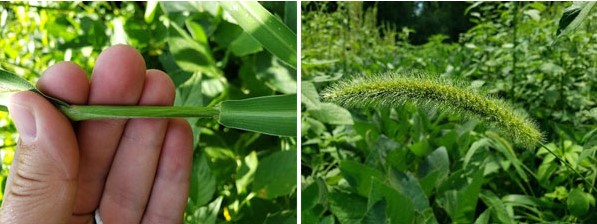By Sarah Lancaster
Green foxtail (S. viridis), yellow foxtail (S. pumila), and giant foxtail (S. faberi) are three closely related annual weeds that can be found throughout Kansas. This article will discuss identification and control of these troublesome grasses. Other names for these plants include bristlegrasses or millets.
Ecology of foxtails
The foxtail species discussed in this article are all annual plants native to Eurasia. There is one foxtail species native to North America, knotroot foxtail, a perennial that is more commonly found in pastures. The annual foxtails discussed here are found on every continent (except Antarctica) and in every state. They can be found throughout Kansas in cultivated fields, pastures, lawns, roadsides, and other disturbed areas. Annual foxtail species were most likely introduced with European immigrants. Giant foxtail quickly became established in agronomic systems as 2,4-D became widely used to remove broadleaf weed species in corn and cereal grains. Foxtail seed can survive up to 30 years in the soil, but typically persist for three years or fewer. Seeds are eaten by many birds and the plants provide some habitat for pheasants and quail; however, bristles may injure grazing animals.
Foxtail species are able to emerge in soil temperatures as low as 33 F, but most emerge in early April. Seedlings have first leaves that are wider than they are long and nearly parallel to the ground.
Identification
There are two keys to identifying foxtail seedlings, ligules and leaf hairs (Figure 1). All three species have a fringed ligule; however, there are some differences among them (Table 1). In addition, all three species have hairs either on the leaf blade or sheath, with giant foxtail having short hairs covering the upper leaf surface and yellow foxtail have a few wispy hairs at the base of the leaf, while green foxtail leaves are hairless.
Foxtails are easily identified by their bristly, cylindrical panicles that develop as the days get shorter. Panicles are made of many spikelets, which each produce one ovate-shaped, wrinkly seed. Several bristles are attached at the base of each spikelet.

Figure 1. Giant foxtail collar region (left) and panicle (right). Note the membranous ligule with a fringe of hairs and the hairy sheath margins.